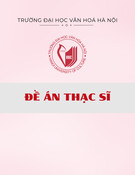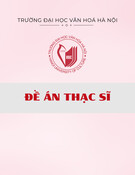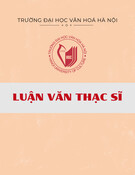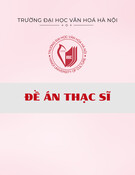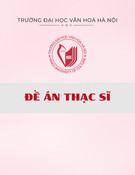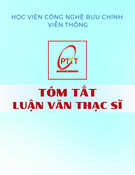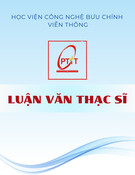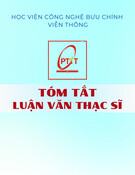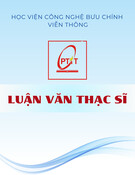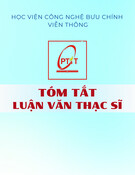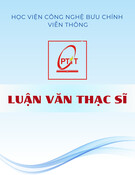
1
Tessellation: Exploring Pathways and Partitions
A thesis submitted in fulfilment
of the requirements for the degree of Master of Arts
Antonia Elizabeth Sellbach,
BA Fine Art (Honours)
School of Art
Design and Social Context Portfolio
RMIT University Melbourne
May, 2011

2 3
Acknowledgments:
I would like to extend many thanks to my supervisor Irene Barberis for her enthusiasm, enouragement and
support throughout this process. I am also grateful to Robin Kingston for her insight and support. Many
thanks to Sarah Trotter, Karla Way, Ali McCann, Mai Gryffyd and Luke Horton for assisting with the various
installs - I would never have managed to get through that process in one piece without you all.
Thank you also to my family, Mary, Undine and Anna Sellbach and Roger Fay for your enriching and ongo-
ing dialogue about this project as it progressed.
Thank you,
Antonia
Declaration
I certify that except where due acknowledgement has been made, the work is that of the author alone; the
work has not been submitted previously, in whole or in part, to qualify for any other academic award; the
content of the thesis is the result of work which has been carried out since the official commencement date of
the approved research program; any editorial work, paid or unpaid, carried out by a third party is acknowl-
edged; and, ethics procedures and guidelines have been followed.
Antonia Sellbach
18/5/2011

4 5
TABLE OF CONTENTS
PROJECT PROPOSAL_________________________________________ 5
DOCUMENTATION OF PROJECT______________________________20
SECTION 2.1: METHODS________________________________________________21
SECTION 2.2: STUDIO INSTALLATIONS___________________________________29
SECTION 2.3:ASSEMBLAGE AND DISASSEMBLAGE _________________________71
SECTION 2.4: EXHIBITIONS______________________________________________85
SECTION 2.5: COMMISSIONS___________________________________________ 167
SECTION 2.6 FINAL EXHIBIT___________________________________________169
SECTION 2.7 INVENTORY_____________________________________________177
CURRICULUM VITAE_______________________________________184
CRITICAL FEEDBACK: Archival Study by Phoebe Ross_____________188
Title:
TESSELLATION: EXPLORING PATHWAYS AND PARTITIONS
Summary:
This research project will investigate how combining systems of tessellation1, modularity2 and seriality3 can be
utilised with a specific method of paper staining to explore visual pathways within an artwork. A serial system4
of modular tessellation will be implemented, whereby different “sets” of oil-and-pigment soaked paper modules
will be constructed and formed into various configurations. 5 These configurations will then be documented
within the architectural spaces of studio and gallery, in order to explore how the same set of paper modules may
reveal a variety of visual outcomes in the form of visual pathways, divisions and partitions.
The research will also involve looking at how the visual aspect of tessellated forms in pavements, floors, path
ways and walls, can affect and even guide one’s spatial experience as we move through an environment. This
quote from the book Italian Pavements: Patterns in Space by Kim Williams outlines some of the functions of
tessellations within the pavement, “By articulating the surface upon which we move through space, the pave-
ment provides a sort of map or visual guide to interpret the spatial experience.” 6
I intend to review this concept in connection to the creation of my own work, by creating configurations which
explore the pathways that the eye may travel.
I also intend to explore the work of other artists including Sol Lewitt, Kerrie Polliness, Jim Lambie, Walter
Obholzer and Ellsworth Kelly who have utilised similar principles or systems of modularity, tessellation and
seriality within their work.
1 Definition of the word ‘Tessellate’ “to fit together exactly” taken from The Collins Dictionary, Harper
Collins, Sydney 1995
2 Definition of the word ‘Modular’ “Designed with standardized units or dimensions, as for easy assem-
bly and repair or flexible arrangment and use” taken from The American Heritage Dictionary of the English
Language, Fourth Edition, Houghton Mifflin Company, 2000
3 Definition of the word ‘Seriality’ “The quality or state of sucsession in a series; sequence” taken from
The Unabridged Dictionary, Random House, 2006
4 Definition of the word ‘System’ An organised and coordinated method; a procedure” taken from The
Unabridged Dictionary, Random House, 2006
5 It is worth pointing out that the system i will use, does allow room for intuitive decision making as
this may affect the outcome of the research
6 Kim Williams, Italian Pavements: Patterns in Space, Anchorage Press, Houston, 1997 p.3

6 7
TESSELLATION: EXPLORING PATHWAYS AND PARTITIONS
Introduction:
The aim of this project is to explore visual pathways within a series of tessellated art works. The term ‘visual
pathway’ may in this case extend to include disruption of space and surface, the partitioning of space and
surface, as well as the exploration of various pathways that flow through space and surface. Kim Williams
suggests in ‘Italian Pavements: Patterns in Space’ that tessellated patterns: “…may enhance, modulate, or even
contradict the qualities of the architectural space. An overall pattern may unite the disparate spaces of a sprawl
ing architectural interior. A break in a continuous pattern may signal a transition in the space. A pattern may
indicate continuity of movement through space, or provide an obstacle to movement.”7
I will investigate how my art works relate to the different architectural surfaces that they are attached to. Ex-
isting research into the functions of tessellated spaces and in particular tessellated walls and pavements will
be further explored and are also the impetus for this project. I intend to look at how my own specific process
and methodology can be compared to the processes and the functions of tessellation found within both his
torical and contemporary walls and pavements.
Here, as Williams points out: “Paving designs demonstrate many of the perceptible qualities that influence our
experience of architecture: scale, texture, a sense of movement, colour. We may perceive a pattern as being static
or implying movement. We may perceive a rhythm. Colour may be used to heighten the effect of the pavement or
to emphasize an important point of action in the space.” 8
7 Kim Williams, Italian Pavements: Patterns in Space, Anchorage Press Houston, 1997 p.1-2
8 ibid p.2
Historically, pavement and wall tessellations often functioned to structurally organise the surface. They have
served as visual cue or guide, mapping, pre-empting and projecting ideal or intended movements through
space. Good examples of this can be found within the Alhambra Palace in Southern Spain, which features
many colourful geometric wall and floor tessellations. Floor tessellations within the palace reveal coloured
central pathways, snaking through the corridors. These can be seen to visually suggest directional movement
throughout the space. My research investigates the potential for this sort of function to be explored and
potentially updated, within a contemporary art context primarily adapted to the eye rather than the body.
This project involves the construction, placement and documentation of geometric modules into various
configurations. These sets of geometric modules will be created through a process of staining paper with
pigment and linseed oil. This process allows a known material such as paper to reveal a new materiality where
its structures are changed or fused with another medium, in this case, linseed oil. Linseed oil has been
chosen because pigments and oil paints may be dissolved into it creating a coloured oil solution with which
to stain the papers. The linseed oil also provides a very specific waxiness and heaviness to the paper, suggest
ing a new materiality. The linseed oil and paint solution will darken slightly over time, thus deepening the
hues of each module slightly.
In this project I will investigate how art works can be constructed that might manipulate, affect or guide the
viewer’s eye on a visual journey through and around the work and also how the work might visually fuse with
the surface of floor, wall etc.
This project will also expand on existing historical research within the area of Abstraction and Conceptual
Art, and in particular, the statement by Sol Lewitt from his article Paragraphs on Conceptual Art:
“Using a simple form repeatedly narrows the field of work and concentrates the intensity of the arrangement of
the form. This arrangement becomes the end while the form becomes the means. “
This statement provides a context for the use of a particular set of rules or ‘system’ within this research, yet
also offers a point from which to differ. I wish to expand on Lewitt’s statement, creating work where the

8 9
form is still the means, but the end, arrangement, or outcome is not finite. In this case, the decision making
processes and working modes are selective, and these qualities could be seen to differ from Lewitt’s statement.
For instance all permutations of the set of modules may not be displayed or configured as the system will
incorporate aesthetic decision making practice modes which may ‘intervene’ with the usage of the system.
Background:
This project involves the staining of thick printmaking paper with coloured pigments and linseed oil. I have
developed and worked with this technique previously, yet in the earlier works the paper was saturated cen-
trally and never stained to the perimeter. I observed that the dry paper edge ‘framed’ each separate work that
I created. Once I applied the stain right to the edges of the paper, I observed how this approach allowed the
artworks to appear like ‘modules’ that could be placed against one another in a variety of combinations. This
process allowed my work to extend beyond the boundaries of the paper through modular composition.
This also led to a shift in my practical methodology, which is the impetus of this project. The questioning of
modularity, seriality and tessellation directly relates to a current questioning within my own art practice, as
well as an overall questioning of how my work fits into a larger spectrum of geometric works in both contem-
porary art and urban spaces. The new work involves the tearing and cutting of large stained paper modules
into geometric shapes that can be organized into tessellated patterns and formations.
Review of literature and current practice:
The book ‘The Mediation of Ornament’ by Oleg Grabar discusses the functions of geometry as an interme-
diary to a wide variety of fields such as architecture, science, design art and decoration. Here, Grabar
writes, “geometry appears, as a frequent category to classify, describe, and comprehend the visual experience of
many objects or monuments of architecture. It is also part of the process of creating things...” 9 This statement
reveals an already existing research framework which links geometry to many fields. I will build upon this
statement by examining the link between the tessellation of geometric form, architecture and contemporary
art within my own tessellation process
9 Oleg Grabar, The Mediationof Ornament, Princeton University Press, New Jersey, 1992 p.135
Grabar also refers to the late Dutch graphic artist, M.C Escher in The Mediation of Ornament particularly in
reference to his use of Tessellation in order to cover space. This provides another context for the area of
research that I intend to explore. Grabar writes, “Escher argues that there is a game of covering space, that is to
say, that it is a desired activity with rules but without certainty about outcome. The geometry of what became \
known technically as ‘tessellation through isometry’ (totally covering with repeated motifs) is one way, perhaps
the only one, of playing the game.”10 Escher was particularly inspired by the geometric tessellations found
within the Alhambra Palace. I intend to visit this site as part of a research trip later this year (see timeline).
Kim William’s book entitled ‘Italian Pavements: Patterns in Space’ provides useful reference to some of the
functions of tessellation within historical pavements and walkways. In depth analysis of tessellations within
various pavements are provided
Sol Lewitt’s ‘Wall Drawing’ series relies on following a set of rules or a system that reveal an outcome. The
series utilised a system whereby sets of diagrammatic instructions were followed to explore the permutations
of simple geometrical combinations and shapes, and the juxtaposition of various colours tones and hues. His
work is pertinent to this research because of his use of a systematic working methodology but also because
he, or others following his instructions would often draw directly onto the walls and floors of the space, thus
engaging with a re-visioning of the potential of architectural surfaces within the gallery and also public and
private spaces. Modular forms were also commonly used within his practice
Contemporary Australian artist Kerrie Poliness has used tessellating geometric forms in her painted works.
She has offered her own interpretation of Lewitt’s systematic and conceptual approach. Her series entitled
‘Black O Wall Drawings’ from 1998 revolved around the usage of a set of instructions that are followed and
can be seen as also expanding on Lewitt’s Wall Drawings, offering a contemporized approach to this idea.
The article ‘The Serial Attitude’ by Mel Bochner taken from the book Open Systems addresses the rise of
systems art and serialty in the 1960s and 1970s . He conveys serial art as utilising a systematic process, fa-
10 ibid p.135

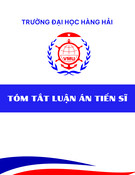

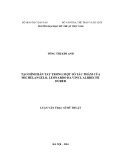


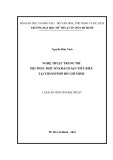
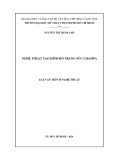
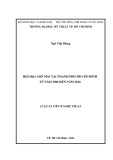


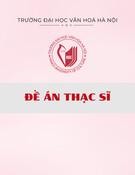


![Đề án Thạc sĩ: Tổ chức hoạt động văn hóa cho sinh viên Trường Cao đẳng Du lịch Hà Nội [Chuẩn nhất]](https://cdn.tailieu.vn/images/document/thumbnail/2025/20251202/kimphuong1001/135x160/91661764646353.jpg)
